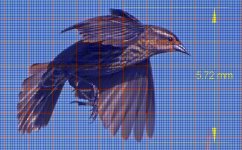a friend of mine shifted habit from regular shutter button operation , to back-button focusing , he feels his images are coming out clearer and really likes this other technique.. but why would this make a difference if this technique is the same as single finger pressing of the shutter release button?
I agree, why would it? My take is the shutter button is placed better to be more able to press it without camera shake. The AE/AL is a programmable function button to change the way focus or exposure is locked, if desired. But you know that if they came out with a radio operated iPhone button, a certain percentage will swear it really helps.
I am old fogy, but other than film speed, cameras have historically had only two controls, shutter speed and aperture. These still work the same today. Shutter mechanisms are faster now, and the CPU chip has made big changes in how focusing is done, but stopping motion still depends on shutter speed in the same way it always did. But of course, we can hear lots of opinions now.
I'm occasionally really cranking up on shutter speed I can gotten up to even 6000th of a sec and I still cant see the same fine scale details that I can on similarly distanced motionless birds but that softness could be for several reasons.
Then I would first suspect a focus issue? Focus on a fast bird is certainly a different situation than a sitting bird.
Another issue , is that Im looking at getting a longer lens , do I need it to have VR if its going to be used at higher shutter speeds as well? If I got a faster lens , would this be better or worse at freezing for detail than trying to use a speedlight If I'm taking my pix in decent ambient light anyway?
The speedlight at low power (close range) will be much faster than any shutter speed, but seems not generally applicable to fast moving or distant birds. For this speedlight advantage to be true, ambient needs to be underexposed at least a couple of stops, so the continuous ambient will not let shutter speed (1/250 second) blur what the speedlight already stopped.
VR does NOT affect focus or subject motion. Its sensor is only about camera motion (shake). Common consensus is to turn VR off if not needed, or said better, turn it on when it is needed. Nikon says turn it off on a tripod, but to me, a fast shutter would seem to be the same thing. If it can't help, it can't hurt to turn it off. But I don't know if it matters or not. It seems clear it cannot help though.
Regardless of the rules of thumb that some folks may find works for them - just physically speaking, without subjective overlay , VR isnt conclusively helping or harming anything in the image at shutter speeds over sync,, so you can just leave it on if you're shooting handheld and have the advantage of a steadier view of your bird.
Dunno, but it seems to me that if shutter speed makes VR unnecessary (shake), then anything VR might do anyway then is unwanted. But VR is never about subject motion or focus, it does not follow the subject.
And a 42.6mph rate of motion is entirely feasible for a vertically moving birds wing.
42.6 MPH is 17.2 inches/second, and in 1/250 second, is 0.068 inches (approx 1/16 inch). This is speaking of shutter slit travel (distortion), exposure and motion freezing can be a few stops faster.
It is said that a 1/25000 second speedlight flash (about 1/64 power at close range) is needed to stop hummingbird wings, but debateably, in practice, 1/8000 seems to do a reasonable job.
This is actually a discussion I did not intend to participate in.


